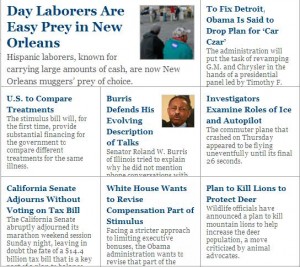It’s the pit of winter and the economy is stuck in molasses, yet the tone in the newspaper business has turned brighter. The few publishers who aren’t weighed down by crushing debt are talking tough and a paid news model is getting renewed attention.
Charlie Rose convenes a panel of industry notables, including The Wall Street Journal‘s Robert Thomson, Time‘s Walter Isaacson and New York Daily News owner Mortimer Zuckerman, who provides comic relief (See “And Finally…” below). The issue is “The Future of Newspapers,” and Poynter has thoughtfully provided a transcript.
Thomson’s comments are the most insightful. He hits the nail on the head with his description of Google as the great leveler: “Google is great for Google, but it’s terrible for content providers, because it divides that content quantitatively rather than qualitatively.” He also has razor-sharp criticism for editorial arrogance. “There’s a great tendency for journalists to be high and mighty, and to underestimate the intelligence of readers. And I think one of the reasons they’re losing readers is for that very reason.” And he says the Journal now “loves” the paid-subscription model it considered abandoning only about a year ago.
 Everyone marvels at the new Amazon Kindle (right) and declares that it may be the last chance to create a reader-funded news model. Isaacson says the challenge for newspapers is to “prevent us from giving it away for free on the Kindles…just like we gave it away for free on the Web. We’ve got one more shot at it… Let’s make some really cool…applications we can…actually charge for.” Tom Foremski and Greg Sterling both have interesting comments on the roundtable.
Everyone marvels at the new Amazon Kindle (right) and declares that it may be the last chance to create a reader-funded news model. Isaacson says the challenge for newspapers is to “prevent us from giving it away for free on the Kindles…just like we gave it away for free on the Web. We’ve got one more shot at it… Let’s make some really cool…applications we can…actually charge for.” Tom Foremski and Greg Sterling both have interesting comments on the roundtable.
Watch the video here:
Making the Case
The New York Times has an op-ed by Eduardo Porter that argues that no other entity can take newspapers’ place. Citing numerous historical precedents, he argues that populations with an active media enjoy higher voter turnout, better government services and a higher standard of living. “During the Great Depression, the Federal Emergency Relief Administration doled out more money in counties with more radios,” he writes, in just one example. “Today, Hispanic voter turnout is higher, relative to the non-Hispanic vote, where there is a local Spanish-language TV station.” He also says television has been cited as an important factor in declining voter turnout beginning in the 1950. Porter’s use of these distant mirrors is novel, but his assumption that it takes a newspaper for a population to achieve these benefits is a bit of a stretch.
The former CEO of Cox Newspapers makes a plea for embattled newspaper companies to fight back. Jay Smith retired eight months ago, just as the walls were beginning to cave in, and he recently joined with three top executives from the business to talk about the industry’s plight. “Their passion and enthusiasm contrasted with…the bleak forecasts for newspapers,” he writes. “Their voices have not been heard much, but they should be.” In particular, “Donna Barrett, who runs the 140 newspapers of Birmingham, Ala.-based CNHI Inc., says nothing in the financials of her company resemble the gloom and doom she reads about.” And the publisher of Parade magazine says he’s still delivering a convincing ROI to advertisers.
Smith is right that these publishers aren’t being heard, and why not? If CNHI is bucking the industry trend, we’d think the Newspaper Association of America would be parading her around like a football hero. It’s odd that those individuals are so quiet when their business is under such siege.
Speaking of sieges, check out the comments at the end of this piece. They’re typical of the reactions we see to published commentaries on the industry’s future: political bashing of the media by both left- and right-wing ideologues accusing newspapers of liberal or conservative bias. This response is so common that we wonder if it’s a coordinated campaign. The comments invariably have nothing to do with the original commentary. They seem designed to spread some kind of agenda. Does anyone have a theory as to why this criticism turns up with such mind-numbing frequency?
But Will They Pay?
Eric Alterman, who penned last spring’s riveting account of the newspaper industry’s problems in The New Yorker, updates the scene in a shorter account on The Nation. Unfortunately, he has no better ideas for saving the industry than anyone else. Alterman recaps the solutions that have been proposed, ranging from micropayments to charitable support, and finds them all wanting. And he points out that the core news section of the typical major metro daily is the part most at risk. “Ironically, it is the sections of the paper most crucial to informed democratic discourse that are in danger of disappearing,”Alterman writes. “Sports news, entertainment news, health news, fashion, celebrity and style reporting will always be with us in one form or another, because they are such delightful places to advertise.” In contrast, no one wants their ad to appear next to a story about an airplane crash.
Writing on Nieman Journalism Lab, Matthew Ingram basically agrees. Ingram recaps the recent debate and says there’s no way readers are going to pay the freight. “Newspapers have never been paid directly by readers for the news,” he writes, adding that subscription and or newsstand fees cover, at best, a few pages worth of production cost. “What newspapers need to do is find ways of creating content that is more valuable than the perishable daily news.” Ah, but that is the problem. No one short of a few specialized publishers has figured that one out.
Miscellany
Three weeks after it pulled the plug on a print advertising program, Google has cancelled a second offline initiative. Google Audio Ads was the second leg of the stool that Google was building to support its expansion into offline advertising. Like Print Ads, the program was meant to upsell airtime to search advertisers. However, the radio industry never much took to the idea, seeing it as a way to commoditize its business. Only one major station owner, Clear Channel Radio, signed on to the program and many smaller networks gave Google the cold shoulder. The search giant still has a similar program to sell television ads and analysts say that one probably isn’t going away soon. About 40 people will lose their jobs.
Have you tried the The New York Times’ new article skimmer? We just did and pronounce it cool. The as-yet-unnamed service (though we like “skimmer” just fine) attempts to recreate the experience of scanning a printed newspaper on a computer screen. Each “page” includes a tiled assortment of summaries and sections slide pleasingly into place. Coolest feature: “Instead of displaying dates, articles gradually fade as they get older,” says a post on the Times‘ First Look blog. ReadWriteWeb notes that it would be nice if you could read the articles in the same interface. But first things first. This is a nice new idea.
And Finally…
 Is Mortimer Zuckerman losing it? Or perhaps the collapse in value of his Manhattan real estate holdings has addled his mind just a bit. In this exchange from the Charlie Rose interview referenced above, Zuckerman oulines his plans to turn around the Daily News through the addition of color:
Is Mortimer Zuckerman losing it? Or perhaps the collapse in value of his Manhattan real estate holdings has addled his mind just a bit. In this exchange from the Charlie Rose interview referenced above, Zuckerman oulines his plans to turn around the Daily News through the addition of color:
I committed to the new presses out of sheer passion 18 months ago…They will dramatically increase our revenues, because we’ll have all color, and this will increase our advertising revenues, and it will also increase our circulation, because it will be a completely transformed visual product.
The Daily News is one of the last newspapers to go to color. Printing in color isn’t helping anyone right now. But just wait a few years and Zuckerman’s daughter will figure out the solution:
I own The Daily News and I’m determined to keep The Daily News going because my daughter, who is 11, is now committed to be the next publisher…She’s agreed. She liked the working conditions. She liked the demands.
Rose comments, delicately, “Most people would hear you say that, and they would say, you know, he doesn’t — with all due respect, you don’t get it.”
Comments
This entry was posted on Monday, February 16th, 2009 at 7:36 am and is filed under Facebook, Fake News, Hyper-local. You can follow any responses to this entry through the RSS 2.0 feed. Both comments and pings are currently closed.




Hi Paul – I blogged recently about the future of newspapers, including ideas for how NYTimes.com can transform their readers’ experiences – here’s the blog entry:
http://allvirtual.wordpress.com/2009/02/14/the-future-of-newspapers-online-interactive-communities/
I wonder if talk about an industry wide pay-for-content model doesn’t run afoul antitrust laws …
I think that the micro-payment model can work and avoid the antitrust laws by being tied to any credit/debit card.
What is needed is an open-source payment model which would essentially eliminate the ‘single payer’ option for any credit/debit card processor.
The benefits for being first are huge volumes of transactions with fractions of pennies per transaction in revenues for the processor.
What is required is a much streamlined verification process which some AI could apply when checking the transaction to limit the damage possible and the fiscal exposure for any processor.
This would require that some existing legislation to be adapted.
To Jake:
Antitrust Laws applying to industry wide pay-for-content model? What about the fact that the Federal Reserve (a private corporation) is already doing it in all matters of exchange?
An industry wide model would only run afoul of the law if there was some collusion to keep prices artificially elevated.
There would only be antitrust issues if all newspapers agreed to make their content paid, which will never happen. Any payment system would most likely be open sourced and supported by multiple vendors. I don’t see any problems.
If you liked the NY Times “Skimmer” you’ll love http://www.newser.com
Take some time and play with it.
Ah-mazing!
The free market has determined the value of journalists’ output.
That value closely approximates zero.
The problem is not the Internet, or the consumers — it’s the product.
[…] The Search for Solutions (newspaperdeathwatch.com) Sphere: Related Content Tweet This Post […]